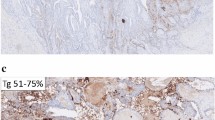Summary
In this study we analysed DNA-ploidy as a potential prognostic parameter in papillary thyreoid carcinoma. Paraffin embedded histological material, obtained by resection from 19 patients with a papillary thyreoid carcinoma, was selected for analysis. Tumor areas within the paraffin-embedded material were identified by HE-stained reference sections. One 50 pin section was dewaxed, rehydrated and mechanically and enzymatically prepared to form a suspension of 10,000 cells/ml. 1 ml of the suspension, which contained bare nuclei with small rests of cytoplasma, was centrifuged on glass slides. The fixed nuclei were air-dried and stained by Feulgen SITS technique, which allows for the quantitative measurement of DNA. The DNA analysis was carried out with a computer-controlled single-cell cytophotometry. In contrast to using flow cytometry, only the tumor cells were measured by image-cytometry. Overlapping nuclei, dirt and other artifacts as well as inflammatory cells were efficiently eliminated. With DNA image-cytometry, we could differentiate between diploid (n = 13) and aneuploid (n = 6) tumors. Best prognosis with a survival rate of 92% after 103 months had patients with diploid tumors in contrast to patients with aneuploid tumors who did not survive more than 72 months.
Zusammenfassung
Bei 19 Patienten, bei denen wegen eines papillären Schilddrüsenkarzinomes eine Resektion durchgeführt worden war, wurde neben der TNM-Klassifikation und den üblichen morphologischen Beurteilungskriterien zusätzlich eine bildanalytische DNS-Zytometrie durchgeführt. Es fanden sich 13 diploide and 6 aneuploide Tumoren. Bei Patienten mit diploiden Tumoren betrug die rezidivfreie Überlebensrate Bowie die Überlebensrate nach 103 Monaten 84% bzw. 92%, wäh-rend 3 von 6 Patienten mit nichtdiploiden Tumoren in nerhalb von 70 Monaten ein Rezidiv erlitten. Zwischen dem DNS-Gehalt der Tumoren einerseits and dem Tumorstadium, der pT-Einteilung, dem Vorhandensein von Lymphknotenmetastasen and einer tumorbedingten Gefäβinfiltration andererseits fand sich kein Zusammenhang.
Similar content being viewed by others
Literatur
Bacourt F, Asselain B, Savoiet JC et al. (1986) Multifactorial study of prognostic factors in differentiated thyroid carcinoms and a re-evaluation of the importance of age. Br J Surg 73:274–277
Bäckdahl M, Carstensen J, Auer G, Tallroth E (1986) Statistical evaluation of the prognostic value of nuclear DNA content in papillary, follicular, and medullary thyroid tumors. World J Surg 10:974–980
Böttger Th, Ungeheuer E (1988) Struma maligna — Eigene Erfahrungen und primäre Ergebnisse. Krankenhausarzt 61:615–620
Böttger Th, Klupp J, Gabbert H, Junginger Th (1991) Prognostisch relevante Faktoren beim papillären Schilddrüsenkarzi-nom. Med Klin (im Druck)
Böttger Th, Störkel S, Stöckle M et al (1991) Bildanalytische DNS-Cytometrie zur Prognosebeurteilung nach Oesophaguscarcinomresektion. Chirurg (im Druck)
Böttger Th, Störkel S, Stöckle M, Gerber B, Junginger Th (1991) Bildanalytische DNS-Cytometrie - Eine Möglichkeit zur Beurteilung der Prognose nach Resektion von ductalen Pankreascarcinomen? Chirurg (im Druck)
Bondeson L, Ljungberg O (1984) Occult papillary thyroid carcinoma in the young and the aged cancer. Cancer 53:1790–1792
Cady C, Rossi R, Silverman M, Worl M (1985) Further evidence of the validity of risk group definition in differentiated thyreoid carcinoma. Surgery 98:1171–1178
Carcangiu ML, Zampi G, Pupi A, Castagnoli A, Rosai J (1985) Papillary carcinoma of the thyroid. Cancer 55:805–828
Cohn K, Bäckdahl M, Forsslund G et al (1984) Prognostic value of nuclear DNA content in papillary thyroid carcinoma. World J Sur 8:474–480
Cusick EL, MacJntosh CA, Krukowski ZH, Ewen SWB, Matheson NA (1990) Comparison of flow cytometry in papillary thyroid carcinoma. Br J Surg 77:913–916
Driel-Kulker AMJ v, Mesker WE, Velzen JV, Tanke HJ, Feichtinger J, Ploem JS (1985) Preparation of monolayer smears from paraffin embedded tissue for image cytometry. Cytometry 6:268
Driel-Kulker AMJ v, Ploem JS (1982) The use of Leytas in analytical and quantitative cytology. IEEE transactions on biomedical engineering. Vol BME-29, 2:92
Emdin SO, Stenling R, Roos G (1987) Prognostic value of DNA content in colorectal carcinoma. Cancer 60:82
Hay JD, Grant LS, Taylor WF, McConahey WM (1988) Ipsilateral lobectomy versus bilateral lobar resection in papillary thyroid carcinoma: a retrospective analaysis of surgical outcome using a novel prognostic scoring system. Surgery 102:1088–1095
Joensuu H, Klemi P, Eerola E, Tuominen J (1986) Influence of cellular DNA content on survival in different thyroid cancer. Cancer 58:2462–2467
Katzetazin K, Saito T, Kobayashi M (1989) Flow cytometric analysis of nuclear DNA content in esophageal cancer. Cancer 64:887
Kerr DJ, Burt AD, Boyle P, MacFarlane GJ, Storer AM, Brewin TB (1986) Prognostic factors in thyroid tumours. Br J Cancer 54:475–482
Mazzaferri EL, Young RY (1981) Papillary thyreoid carcinoma: a 10 years follow-up report of the impact of therapy in 576 patients. J Am Med Assoc 70:511
Meyer F (1979) Iterative image transformation for automative screening of cervical smears. J Histochem Cystochem 27:128
Sasaki K, Hashimoto T, Kawachino K (1988) Intratumoral regional differences in DNA ploidy of gastrointestinal carcinomas. Cancer 62:2569
Schröder S, Dralle H, Rehpenning W, Böcker W (1987) Prognosekriterien des papillären Schilddrüsencarcinoms. Langenbecks Arch Chir 371:263–280
Stöckle M, Tanke HJ, Voges G, Riedmiller H, Hohenfellner R (1989) DNA-histogramm of invasive bladder carcinoma: comparison of flow cytometry and automated image analysis. In: Rübben J, Jacobi HG, Jochan M (eds) Investigative urology 3. Springer, Berlin Heidelberg New York, pp 107–114
Tanke HJ, van Ingen EM, Ploem JS (1974) Acriflavine-Feulgen stilbene staining: a procedure for automated cervical cytology with a television based system (Leytas). J Histochem Cytochem 27:84–86
Teodoli L, Tirindelli-Dauesi D, Cordelli E (1986) Potential prognostic significance of cytometrically determined DNA abnormality in GI tract human tumors. Ann NY Acad Sci 468:291
Author information
Authors and Affiliations
Rights and permissions
About this article
Cite this article
Böttger, T., Gabbert, H., Stöckle, M. et al. Erste Ergebnisse der bildzytometrischen DNS-Analyse zur Beurteilung der Prognose beim papillaren Schilddrüsenkarzinom. Langenbecks Arch Chir 376, 158–162 (1991). https://doi.org/10.1007/BF00250341
Received:
Issue Date:
DOI: https://doi.org/10.1007/BF00250341




